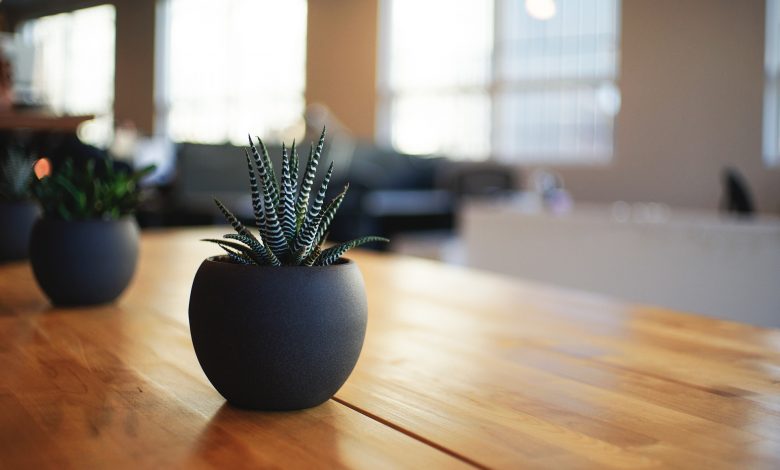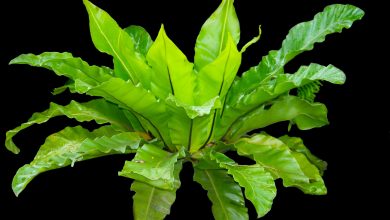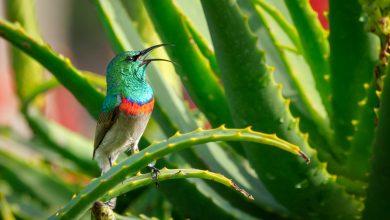9 Houseplants Safe for Cats and Dogs

As a pet owner, you know that particular living items are certain to attract your furry friend’s attention. Some dogs will munch on grass as if they were cows in a pasture, while cats can be drawn to specific smells or appearances as easily as flicking a switch. Luckily, there are plenty of houseplants that are safe for cats and dogs. Houseplants can add a personalized touch to your home décor while also purifying your air.
In addition to these nine houseplants safe for cats and dogs, the Calathea, Echeveria, and spider plants are all non-toxic and were covered in our previous article highlighting 11 of the best small houseplants.

1. African Violet
Saintpaulia ionantha
Level of Care: Expert
Sunlight: Bright but indirect light
Water: Water from the bottom
Soil: Look for African violet specific soil that contains sphagnum, pumice, and perlite
Don’t get too scared off by the “expert” level of care on African violets. But they do require some extra attention that other plants do not if you want your plant to reach its full potential.
The bloom of the flower is best when it is root-bound, but not so root-bound that it becomes unhealthy. To achieve the best blooms and the most comfortable environment for your plant, choose a pot that is one-third of the size of the plant’s spread. For example, if your plant measures nine inches across, you would want a pot that is three inches in diameter. Repot once per year.
African violets are also picky about their water. It’s best to use lukewarm water that has been allowed to sit out for 48 hours. You also should never water the plant from the top. Instead, always water from the base of the plant.

2. Baby Rubber Plant
Peperomia obtusifolia
Level of Care: Beginner
Sunlight: Keep in bright to medium light but out of direct sunlight
Water: Similar to caring for a succulent, wait until the soil has dried out before watering
Soil: Well-draining soil is necessary, as rubber plants do not fare well sitting in water
The baby rubber plant is one of the best options for bringing some greenery into your space without overwhelming you with the amount of attention it needs. Its dense, glossy leaves subtly curl in different directions, adding a fun, lively appearance.
Native to rainforests throughout South America, the baby rubber plant is interesting enough in appearance to add a layer of depth to a room, while also being subdued enough to not take the spotlight away from the rest of your décor.
You will not need to worry much about repotting your plant. If you’ve had it for five years, you may want to consider getting it in some fresh new soil.
You can also easily propagate the baby rubber plant with stem cuttings or using the division method.

3. Baby’s Tears
Soleirolia soleirolii
Level of Care: Intermediate
Sunlight: Bright, indirect light avoiding direct sun
Water: Keep the soil moist but not soggy
Soil: Quick-draining potting soil with a decent amount of peat moss
This plant may carry a sad sounding name, but its delicate and playful appearance will bring a smile back to your face. Baby’s tears are described as “mat-forming” because the plant slowly but steadily grows additional branches that move outward. As a houseplant, baby’s tears can work well in a hanging basket, as the plant grows outward and hangs down the pot.
The intermediate level of care comes into play with the amount of water the plant prefers. Overwatering the plant will cause root-rot, but you still want to make sure that the plant’s soil remains moist. Getting into the right watering routine may take a little practice.
During the growing season, fertilize the plant with any basic fertilizer, but dilute the fertilizer to one-half strength.

4. Boston Fern
Nephrolepis exaltata
Level of Care: Intermediate
Sunlight: Indirect light
Water: Keep the soil damp and mist the plant with a spray bottle
Soil: Look for soil mixtures with high levels of peat moss
Many ferns carry the drawback of high toxicity, but the Boston fern is an attractive option that is safe for kids, dogs, and cats. The best way to utilize a Boston fern is in a hanging basket, but it still looks excellent as a table-top plant.
The Boston fern craves a humid environment, so some people suggest using a humidifier to keep them happy indoors, especially in the wintertime.
If you would rather not mess around with a humidifier, try placing the pot of the fern on something called a humidity tray. Take the tray your pot sits on and and fill it with water and pebbles. You can also use a spray bottle to mist the plant every now and then. You will notice that your fern is not getting enough humidity if the leaves start to turn yellow.
Fertilizer is not very necessary for the Boston fern. If you’d like to fertilize the plant, do so just two or three times a year.

5. Bromeliad
Bromeliaceae
Level of Care: Intermediate
Sunlight: Sun preferences vary, but bright indirect light is the best bet
Water: Can withstand periods without water, but be careful not to overwater
Soil: Well-draining soil
The bromeliad plant is generally easy to care for, and its tropical origins can add an exotic flair to your home décor.
Just like the Boston fern, the bromeliad plant prefers a humid environment, around 60 percent humidity. The suggestions for the fern hold true for the bromeliad. If you have a humidifier, that would be the easiest way to make your bromeliad plant comfortable. But if you do not, or would rather not use it, try making a humidity tray and use a spray bottle to mist.
But keeping the plant humid is about all you will need to do for the bromeliad to grow.
The plant has a relatively short lifespan, but it will produce offshoots called “pups” that you can gather and use to begin new plants. Look for the pups to start growing at the base of the plant. Once they’re large enough to break off, you can cut them and replant in a well-draining potting mixture. Nurture your new plants just as you would the parent plant and enjoy growing them to maturity.

6. Haworthia Zebra Plant
Haworthia fasciata
Level of Care: Beginner
Sunlight: Place near a window that gets plenty of sunlight
Water: As a succulent, this plant should only be watered once the soil is dry
Soil: Look for a well-draining soil mixture specific to succulents
The Haworthia zebra plant checks all the boxes: it’s fun, attractive, and easy to care for.
The plant is easily identified by its many dark green leaves curling up from the bottom of the plant. Highlighting the exterior of the leaves are horizontal white stripes, which make this plant unmistakable.
Similar to the bromeliad, the zebra plant will produce offsets at the base of the plant. Once these are big enough to break off, you can replant in well-draining succulent soil to create new plants.

7. Mosaic Plant
Fittonia albivenis
Level of Care: Intermediate
Sunlight: Full morning sun with filtered sun in the afternoon
Water: Water only when soil is completely dry
Soil: Not picky about the soil composition, but it should be well-draining
Mosaic plants grow wonderfully in both pots and in hanging baskets, where their leaves have room to spread out. The leaves of a mosaic plant are true standouts, with thick white veins spreading intricately across the broad green leaf.
If the leaves begin to turn yellow, you will know that you overwatered the plant.
The mosaic plant is native to South America, so its tropical nature leads to a natural craving for high humidity. As we’ve noted with several other plants, you may want to put your mosaic plant near a humidifier in the winter and keep it on a humidity tray at all times, if possible. Also, try to mist the plant with a spray bottle from time to time.

8. Orchid
Orchidaceae
Level of Care: Intermediate
Sunlight: Bright, indirect light
Water: Once a week
Soil: Fertilize the soil once a week with an orchid-specific fertilizer
The Orchidaceae family is home to over 28,000 different species. Despite the wide variety, orchids are distinguishable by their ornate petals, which always follow a bilateral symmetry. Caring for orchids is not difficult, and they can bloom for multiple months throughout the year. If properly cared for, your orchid can live forever. And with a varied collection of orchids, you can have at least one blooming when you wake up every morning.

9. Polka Dot Plant
Hypoestes phyllostachya
Level of Care: Intermediate
Sunlight: Bright, indirect light
Water: Water whenever you notice the soil is dry
Soil: A rich and well-draining soil is best, so look for organic potting soil and fertilize once a month
The polka dot plant is one of the most striking plants you can put on display. When picking one out, you’ll have your choice of varying pink and green color combinations that are all equally spectacular. The polka dot plant may not be easy to care for, but it is not challenging either, making it an excellent choice for an aspiring gardener.
Due to its tropical origins, the polka dot plant is another humidity lover. Create a humidity tray to place the pot on top of and mist it often. The polka dot plant also prefers warmer temperatures, so place it in a warm area of the house. The plant will also tend to grow outward, so some pruning is necessary. When you see two new leaves growing off the stems, prune them back to keep the plant tidy.



